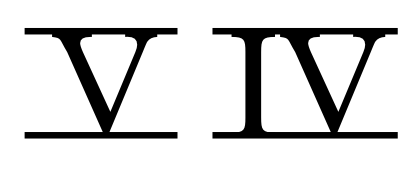In tonal music, we can classify chords in keys to find patterns across pieces of music. So that we can make these comparisons and learn more about how music works, we label chords with Roman numerals.
We use roman numerals from I to VII to label chords built on scale degrees ![]() to
to ![]() . We will also use upper and lowercase to tell the difference among chord qualities. When you write uppercase roman numerals with pencil, please add lines to the top and the bottom of the whole numeral. Something like this:
. We will also use upper and lowercase to tell the difference among chord qualities. When you write uppercase roman numerals with pencil, please add lines to the top and the bottom of the whole numeral. Something like this:

This will help me tell the difference between your uppercase and lowercase numerals.
We say roman numerals with cardinal numbers. For example we call the tonic triad “one.”
Triads in major
| I | ii | iii | IV | V | vi | vii° |
| major | minor | minor | major | major | minor | diminished |
| Do-Mi-Sol | Re-Fa-La | Mi-Sol-Ti | Fa-La-Do | Sol-Ti-Re | La-Do-Mi | Ti-Re-Fa |
Note the degree sign after the lowercase numeral for the leading-tone triad (vii°).
Seventh Chords in major
| I7 | ii7 | iii7 | IV7 | V7 | vi7 | viiø7 |
| major | minor | minor | major | dominant | minor | half dim. |
| Do-Mi-Sol-Ti | Re-Fa-La-Do | Mi-Sol-Ti-Re | Fa-La-Do-Mi | Sol-Ti-Re-Fa | La-Do-Mi-Sol | Ti-Re-Fa-La |
Note the superscript 7 for root position seventh chords, and the slash through degree sign for viiø7.

For seventh chords, we say the word “seven” after the roman numeral when we speak roman numerals. For example, iii7 is said “three seven.”
Triads in minor
| i | ii° | III | iv | V | VI | vii° |
| minor | diminished | major | minor | major* | minor | diminished* |
| Do-Me-Sol | Re-Fa-Le | Me-Sol-Te | Fa-Le-Do | Sol-Ti-Re | Le-Do-Me | Ti-Re-Fa |
*Note that V and vii° use Ti instead of Te. This means an accidental!

Seventh Chords in minor
| i7 | iiø7 | III7 | iv7 | V7 | VI7 | vii°7 |
| major | half dim. | major | minor | dominant* | major | fully dim.* |
| Do-Me-Sol-Te | Re-Fa-Le-Do | Me-Sol-Te-Re | Fa-Le-Do-Me | Sol-Ti-Re-Fa | Le-Do-Me-Sol | Ti-Re-Fa-Le |
*Note that V7 and vii°7 use Ti instead of Te. This means an accidental!

We specify qualities of diminished seventh chords when we speak roman numerals. So, in minor, the supertonic seventh chord is said “two half-diminished seven,” and the leading-tone seventh chord is said “seven fully-diminished seven.”
If you want to specify quality for major and minor chords, say the quality first and then the roman numeral. For example, “minor one” and “major four seven.”
Inversion Symbols
Since there are lots of times when the root is not the lowest note, we need a way to show this with our roman numerals. To do this we borrow our inversion symbols from figured bass.
We pronounce the inversion symbols with cardinal numbers as well, saying them after the roman numeral: the superscript number before the subscript number. For example, we say “two six-five” forii65. (For the most complicated version of this, vii°42 is said “seven fully diminished four-two.”)
Triad Inversions
| Root Position | First Inversion | Second Inversion |
| No added symbol | superscript 6 | superscript 6 and subscript 4 |
| V |
ii6 |
I64 |
Seventh Chord Inversions
| Root Position | First Inversion | Second Inversion | Third Inversion |
| superscript 7 | sup 6 and sub 5 | sup 4 and sub 3 | sup 4 and sub 2 |
| V7 |
ii65 |
V43 |
I42 |

Memorizing Roman Numerals
Please memorize the roman numerals, correct qualities, diatonic pitches (solfege), and inversion symbols for all of these chords in major and minor. You will spend a huge amount of your theory coursework analyzing music with these symbols. The sooner you know them, the better. I cannot overstate this point.
